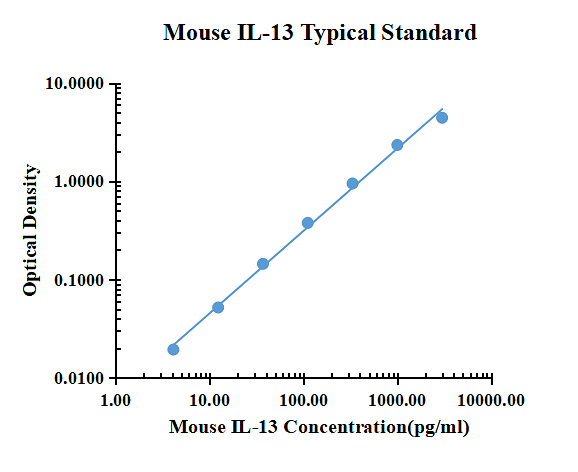Mouse IL-13 enzyme-linked immunoassay kit
| Specification | 96 Test |
|---|---|
| Sensitivity | 0.37 pg/ml (10 μl) |
| Standard Curve Range | 4.12~3000 pg/ml |
| Standard Curve Gradient | 7 Points/3 Folds |
| Number of Incubations | 2 |
| Detectable sample | Liquid phase sample of soluble substances. For example: serum, plasma, cell culture supernatant, tissue grinding liquid, etc. |
| Sample Volume | 10 μl |
| Type | Fully Ready-to-Use |
| Operation Duration | 120min |

| pg/ml | O.D. | Average | Corrected | |
|---|---|---|---|---|
| 0 | 0.0252 | 0.0263 | 0.0258 | |
| 4.12 | 0.0451 | 0.0451 | 0.0451 | 0.0194 |
| 12.35 | 0.0781 | 0.0772 | 0.0777 | 0.0519 |
| 37.04 | 0.1694 | 0.1712 | 0.1703 | 0.1446 |
| 111.11 | 0.4072 | 0.3993 | 0.4033 | 0.3775 |
| 333.33 | 0.9812 | 0.9731 | 0.9772 | 0.9514 |
| 1000 | 2.3813 | 2.3685 | 2.3749 | 2.3492 |
| 3000 | 4.4451 | 4.5012 | 4.4732 | 4.4474 |
Precision
| Intra-assay Precision | Inter-assay Precision | |||||
| Sample Number | S1 | S2 | S3 | S1 | S2 | S3 |
| 22 | 22 | 22 | 6 | 6 | 6 | |
| Average(pg/ml) | 62.3 | 312.1 | 923.2 | 68.9 | 323.2 | 916.4 |
| Standard Deviation | 3.1 | 20.0 | 60.9 | 4.6 | 17.5 | 48.6 |
| Coefficient of Variation(%) | 4.9 | 6.4 | 6.6 | 6.6 | 5.4 | 5.3 |
Intra-assay Precision (Precision within an assay) Three samples of known concentration were tested twenty times on one plate to assess intra-assay precision.
Inter-assay Precision (Precision between assays) Three samples of known concentration were tested six times on one plate to assess intra-assay precision.
Spike Recovery
The spike recovery was evaluated by spiking 3 levels of mouse IL-13 into health mouse serum sample. The un-spiked serum was used as blank in this experiment.
The recovery ranged from 84% to 115% with an overall mean recovery of 101%.
Sample Values
| Sample Matrix | Sample Evaluated | Range (pg/ml) | Detectable (%) | Mean of Detectable (pg/ml) |
|---|---|---|---|---|
| Serum | 30 | 0.73-15.97 | 100 | 2.35 |
Serum/Plasma – Thirty samples from apparently healthy mice were evaluated for the presence of IL-13 in this assay. No medical histories were available for the donors.n.d. = non-detectable. Samples measured below the sensitivity are considered to be non-detectable.
Product Data Sheet
Background: IL-13
IL-13 (Interleukin-13) plays a key role in the pathogenesis of allergy, cancer, and tissue fibrosis. It is secreted by several helper T cell subsets, NK cells, mast cells, eosinophils, basophils, and visceral smooth muscle cells. IL-13 suppresses the production of proinflammatory cytokines and other cytotoxic substances by macrophages, fibroblasts, and endothelial cells. It promotes B cell activation, immunoglobulin class switching to IgE, and the upregulation of CD23/Fc epsilon RII. IL-13 signals through a receptor complex containing IL-13 R alpha 1 and IL-4 R alpha. This complex also functions as the type 2 IL-4 receptor. IL-13 R alpha 2 binds IL-13 and prevents IL-13 from signaling through the IL-13 R alpha 1/IL-4 R alpha complex. IL-13-bound IL-13 R alpha 2 can directly promote tumor cell invasiveness and the development of tissue fibrosis.

